Роберт Каплан - Муссон. Индийский океан и будущее американской политики
42. Камоэнс. Лузиады. Песнь первая: 27.
43. Камоэнс. Лузиады. Песнь пятая: 16.
44. Bowra. From Virgil to Milton. P. 97; Камоэнс. Лузиады. Песнь первая: 64, песнь десятая: 102, 122.
45. Encyclopaedia Britannica, 11th ed. N. Y., 1910.
46. Камоэнс. Лузиады. Песнь первая: 3.
47. Там же. Песнь первая: 99.
48. Там же. Песнь девятая: 1.
49. Bowra, From Virgil to Milton. P. 133, 136.
50. Камоэнс. Лузиады. Песнь четвертая: 99.
Глава 5. Белуджистан и Синд1. André Wink. Al-Hind: The Making of the Indo-Islamic World, vol. 1, Early Medieval India and the Expansion of Islam, 7–11th Centuries. Boston and Leiden, the Netherlands: Brill, 1990, 2002. P. 129.
2. John Keay. The Honourable Company: A History of the English East India Company. L.: HarperCollins, 1991. P. 103.
3. B. Raman. Hambantota and Gwadar – an Update // Institute for Topical Studies. – Chennai, India, 2009.
4. Robert G. Wirsing. Baloch Nationalism and the Geopolitics of Energy Resources: The Changing Context of Separatism in Pakistan // Strategic Studies Institute, U. S. Army War College. Carlisle, PA, 2008. Apr. 17.
5. Wilfred Thesiger. Arabian Sands. N. Y.: Dutton, 1959. P. 276.
6. The Great Land Robbery: Gwadar // The Herald. Karachi, Pakistan, 2008. June.
7. Selig S. Harrison. Ethnic Tensions and the Future of Pakistan. Working paper prepared for the Center for International Policy, 2008.
8. Harrison, Pakistan’s Baluch Insurgency // Le Monde Eiplomatique. 2006. October.
9. International Crisis Group. Pakistan: The Forgotten Conflict in Balochistan // Islamabad / Brussels, Oct. 22, 2007.
10. Ibid.
11. Ibid.
12. Ibid.
13. Wirsing, Baloch Nationalism and the Geopolitics of Energy Resources.
14. Ibid.
15. Wink. Al-Hind. P. 173, 175.
16. Aryn Baker. Karachi Dreams Big // Time (Asia). 2008. Feb. 8.
17. Robert D. Kaplan. Imperial Grunts: The American Military on the Ground. N. Y.: Random House, 2005. P. 37.
18. Ibid.
19. Freya Stark. East Is West. L.: John Murray, 1945. P. 198.
20. John F. Richards. Mughal Empire. N. Y.: Cambridge University Press, 1995. P. 51.
21. William Dalrymple. Pakistan in Peril // New York Review of Books. 2009. Feb. 12.
22. Wink. Al-Hind. P. 213.
23. Joseph A. Tainter. The Collapse of Complex Societies. N. Y.: Cambridge University Press, 1988. P. 6.
24. Burton Stein. A History of India. Oxford, Eng.: Blackwell, 1998. P. 22.
25. W. Gordon East. The Geography Behind History. N. Y.: Norton, 1965. P. 142.
26. Asif Raza Morio. Moen Jo Daro, Mysterious City of [the] Indus Valley Civilization. Larkana, Pakistan: Editions, 2007.
27. Mary Anne Weaver. Pakistan: In the Shadow of Jihad and Afghanistan. N. Y.: Farrar, Straus and Giroux, 2002. P. 181.
28. Tainter. Collapse of Complex Societies. P. 1.
29. Richard F. Burton. Sindh: and the Races That Inhabit the Valley of the Indus; with Notices of the Topography and History of the Province. L.: Allen, 1851. P. 3, 362.
Глава 6. Тревожное становление Гуджарата1. Edward Luce. In Spite of the Gods: The Strange Rise of Modern India. N. Y.: Doubleday, 2007. P. 158–162.
2. Citizens for Justice and Peace, «Summary of the CJP’s Activities Between April 2002 and October 2003», Mumbai.
3. André Wink. Al-Hind: The Making of the Indo-Islamic World, vol. 2, The Slave Kings and the Islamic Conquest, 11–13th Centuries. New Delhi: Oxford University Press, 1997. P. 269.
4. Камоэнс. Лузиады. Песнь десятая: 106.
5. Marshall G. S. Hodgson. The Venture of Islam, vol. 2. The Expansion of Islam in the Middle Periods. Chicago: University of Chicago Press, 1961. P. 546; Alan Villiers. Monsoon Seas: The Story of the Indian Ocean. N. Y.: McGraw-Hill, 1952. P. 109.
6. R. A. L. H. Gunawardana. Changing Patterns of Navigation in the Indian Ocean and Their Impact on Pre-Colonial Sri Lanka // Satish Chandra. The Indian Ocean: Explorations in History, Commerce and Politics. New Delhi: Sage, 1987. P. 81.
7. S. Arasaratnam. India and the Indian Ocean in the Seventeenth Century // Ashin Das Gupta and M. N. Pearson, eds. India and the Indian Ocean, 1500–1800. Kolkata: Oxford University Press, 1987.
8. Engseng Ho. Port City States of the Indian Ocean // Harvard University and the Dubai Initiative. 2008. Feb. 9–10.
9. Sugata Bose. A Hundred Horizons: The Indian Ocean in the Age of Global Empire. Cambridge, MA: Harvard University Press, 2006. P. 75; Charles Verlinden. The Indian Ocean: The Ancient Period and the Middle Ages // Chandra, Indian Ocean. P. 49.
10. Dwijendra Tripathi. Crisis of Indian Polity and the Historian // Indian History Congress, Amritsar, 2002.
11. См. в настоящем контексте: Hoeber Rudolph and Lloyd I. Rudolph. Modern Hate: How Ancient Animosities Get Invented // New Republic. 1993. Mar. 22.
12. Walter Laqueur, ed. Fascism: A Reader’s Guide; Analyses, Interpretations, Bibliography. L.: Wildwood, 1976.
13. Juan J. Linz. Some Notes Toward a Comparative Study of Fascism in Sociological Historical Perspective. См. также: Zeev Sternhell. Fascist Ideology. Оба в: Laqueur. Fascism.
14. Thomas Pynchon. Foreword to George Orwell, Nineteen Eighty-Four. N. Y.: Penguin, 2003.
15. Achyut Yagnik and Suchitra Sheth. The Shaping of Modern Gujarat: Plurality, Hindutva and Beyond. New Delhi: Penguin India, 2005.
16. Камоэнс. Лузиады. Песнь десятая: 60, 64.
17. Amartya Sen. Why Democratization Is Not the Same as Westernization: Democracy and Its Global Roots // New Republic. 2003. Oct. 6.
18. Elias Canetti. Crowds and Power. N. Y.: Viking, 1960.
Глава 7. Взгляд из Дели1. John F. Richards. The Mughal Empire. N. Y.: Cambridge University Press, 1995. P. 122.
2. Ibid. P. 35.
3. Richard M. Eaton. The Rise of Islam and the Bengal Frontier, 1204–1760. Berkeley: University of California Press, 1993. P. 159, 160.
4. Richards. Mughal Empire. P. 239, 242.
5. Sugata Bose. A Hundred Horizons: The Indian Ocean in the Age of Global Empire. Cambridge, MA: Harvard University Press, 2006. P. 56.
6. William Dalrymple. City of Djinns: A Year in Delhi. L.: HarperCollins, 1993. P. 82, 83.
7. George N. Curzon. Frontiers: The Romanes Lecture 1907. 1907; reprint, Boston: Elibron Classics, 2006. P. 57, 58.
8. Lord Curzon of Kedleston. The Place of India in the Empire. L.: John Murray, 1909. P. 12.
9. Parag Khanna and C. Raja Mohan. Getting India Right // Policy Review. 2006. February/March.
10. Stephen P. Cohen. India: Emerging Power. Washington, DC: Brookings, 2001. P. 55.
11. James R. Holmes, Andrew C. Winner, and Toshi Yoshihara. Indian Naval Strategy in the 21st Century. L.: Routledge, 2009. P. 131.
12. Holmes and Yoshihara. China and the United States in the Indian Ocean: An Emerging Strategic Triangle? // Naval War College Review. 2008. Summer. From Ming’s articles «The Indian Navy Energetically Steps Toward the High Seas» and «The Malacca Dilemma and the Chinese Navy’s Strategic Choices».
13. Holmes and Yoshihara. China and the United States in the Indian Ocean.
14. Geoffrey Kemp. The East Moves West // National Interest. 2006. Summer.
15. Heather Timmons and Somini Sengupta. Building a Modern Arsenal in India // New York Times. 2007. Aug. 31.
16. Daniel Twining. The New Great Game // Weekly Standard. 2006. Dec. 25.
17. Greg Sheridan. East Meets West // National Interest. 2006. November / December.
18. Holmes, Winner, and Toshihara. Indian Naval Strategy in the 21st Century. P. 142.
19. Defense Industry Daily, June 6, 2005.
20. Mohan Malik. Energy Flows and Maritime Rivalries in the Indian Ocean Region. Honolulu: Asia-Pacific Center for Security Studies, 2008.
21. Adam Wolfe, Yevgeny Bendersky, and Federico Bordonaro // Power and Interest News Report. 2005. July 20.
22. Khanna and Mohan. Getting India Right.
23. Edward Luce, In Spite of the Gods: The Strange Rise of Modern India. N. Y.: Doubleday, 2007. P. 287.
24. Ibid. P. 275.
25. Twining. New Great Game.
26. Stanley Weiss. India: The Incredible and the Vulnerable // International Herald Tribune. 2008. Apr. 23.
27. Khanna and Mohan. Getting India Right.
28. Sunil Khilnani. India as a Bridging Power // The Foreign Policy Centre, 2005.
29. Harsh V. Pant. A Rising India’s Search for a Foreign Policy // Orbis. 2009. Spring.
Глава 8. Бангладеш: борьба за прозябание1. Alan Villiers. Monsoon Seas: The Story of the Indian Ocean. N. Y.: McGraw Hill, 1952. P. 5.
2. Interview with Jay Gulledge, senior scientist, Pew Center on Global Climate Change, 2009.
3. Richard M. Eaton. The Rise of Islam and the Bengal Frontier, 1204–1760. Berkeley: University of California Press, 1993. P. 306.
4. Samuel P. Huntington. Political Order in Changing Societies. New Haven, CT: Yale University Press, 1968. P. 1, 9, 47.
5. Eaton. Rise of Islam and the Bengal Frontier. P. 235.
6. Камоэнс. Лузиады. Песнь десятая: 121.
7. Suniti Bhushan Qanungo. A History of Chittagong. Chittagong, Bangladesh: Signet. 1988, P. 468.
8. Thant Myint-U. The River of Lost Footsteps: A Personal History of Burma. N. Y.: Farrar, Straus and Giroux, 2006. P. 72.
9. Ibid. P. 110.
Глава 9. Калькутта: очередной город мирового значения1. John Keay. The Honourable Company: A History of the English East India Company. L.: HarperCollins, 1991. P. 220, 272.
2. Камоэнс. Лузиады. Песнь седьмая: 20.
3. Richard M. Eaton. The Rise of Islam and the Bengal Frontier, 1204–1760. Berkeley: University of California Press, 1993. P. 12, 13, 19, 20, 61, 62, 313.
4. Geoffrey Moorhouse. Calcutta: The City Revealed. London: Weidenfeld and Nicolson, 1971. P. 93.
5. Ibid. P. 18.
6. David Gilmour. Curzon: Imperial Statesman. N. Y.: Farrar, Straus and Giroux, 1994. P. 145.
7. Dominique Lapierre. The City of Joy. N. Y.: Doubleday, 1985.
8. William T. Vollmann. Poor People. N. Y.: Ecco, 2007. P. xiv, 111, 123, 124, 239.
9. Madeleine Biardeau. India, transl. F. Carter. L.: Vista, 1960. P. 65, 73.
10. Moorhouse. Calcutta. P. 128.
11. Sunil Gangopadhyay. Those Days, transl. by Aruna Chakravarti. N. Y.: Penguin, 1981, 1997. P. 581.
12. Basil Lubbock. The Opium Clippers. Boston: Lauriat, 1933. P. 13, 14, 16, 17, 28. См.: C. R. Boxer. The Dutch Seaborne Empire, 1600–1800. L.: Hutchinson, 1965. P. 228.
13. Simon and Rupert Winchester. Calcutta. Oakland, CA: Lonely Planet, 2004. P. 32.
14. Keay. Honourable Company. P. 193.
15. Термин «объективно-исторические силы» (vast impersonal forces) ввел T. С. Элиот. См. эссе Исайи Берлина «Историческая неизбежность» (Historical Inevitability), впервые прочитанное на лекции в 1953 г. и опубликованное в его книге «Четыре эссе о свободе»: Isaiah Berlin. Four Essays on Liberty. L.: Oxford University Press, 1969.
16. Thomas Babington Macaulay. Essay on Lord Clive, edited with notes and an introduction by Preston C. Farrar. 1840; reprint, N. Y.: Longmans, Green, 1910. P. xxx, 3, 16, 17.
17. Keay. Honourable Company. P. 289.
18. Ibid. P. 281.
19. Macaulay. Essay on Lord Clive. P. 22.
20. Ibid. P. 24, 25.
21. Keay. Honourable Company. P. 290.
22. Ibid. P. 36, 37.
23. Moorhouse. Calcutta. P. 25, 26.
24. Macaulay. Essay on Lord Clive. P. 39.
25. Ibid. P. 40.
26. Ibid. P. 41.
27. Macaulay. Essay on Lord Clive. P. 43.
28. Ibid. P. 44.
29. Ibid. P. 45.
30. Ibid. P. 45, 46.
31. Keay. Honourable Company. P. 315.
32. Ibid. P. 51.
33. Macaulay. Essay on Lord Clive. P. 59, 60.
34. Ibid. P. 61.
35. Macaulay. Essay on Lord Clive. P. 97.



